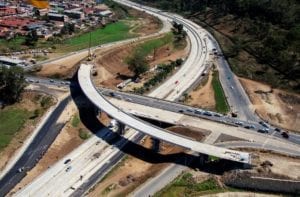The Chota Motala interchange straddles the N3 freeway as a major access route to the Pietermaritzburg CBD. It had been operating at above capacity for quite some time, evidenced by long delays in traffic on the Chota Motala Road (R33). Of even more concern was the dangerous situation created by the backing up of traffic on the off-ramps from the freeway, resulting in through traffic on the N3 suddenly being confronted by stationary traffic in the slow lane. After evaluating several interchange upgrade options, authorities settled on a concrete bridge over the N3 which would create a much-needed third layer of traffic at this busy interchange.
The South African National Road Agency Limited (SANRAL) and the Mzunduzi Municipality then appointed Aurecon, in joint venture with Illiso, for the detailed design of the upgraded interchange, with Aurecon responsible for all bridge work. The main determining factor in the conceptual design for the bridge was the client’s requirement that any new bridge over the N3 had to be constructed without disrupting or endangering the heavy traffic on the N3 freeway. It was for this reason that Aurecon proposed the construction of an incrementally launched bridge. The incrementally launched construction method involves construction of the bridge superstructure section by section on one side of an obstacle and then launching them sequentially into their final position. Although this technique has been in use for approximately 50 years – the first post-tensioned concrete bridge constructed by launching is believed to be over the River Caroni in Venezuela in 1963 – this type of structure continues to be demanding in both the design and construction. “The incremental launch technique was considered ideal for this situation,” comments Aurecon project manager, Hennie Niehaus. “With very little risk of disrupting traffic at any stage during construction, it met the client’s requirements in every respect.” Reinforced concrete was deemed to be the logical choice of construction material for the Chota Motala Bridge as it offers the lowest initial construction cost and lowest life-cycle maintenance costs. The only alternative was a launched composite deck involving the launch of open steel box-girder over the whole length of the bridge and casting a concrete slab on it at a later stage. However, this option was not considered further because it is generally more expensive than a concrete bridge deck, has much higher maintenance costs and the construction of the concrete top slabs would have posed a safety risk to traffic on the N3, negating the main advantage of the launch bridge. The bridge was designed as a 220 m long deck consisting of a single cell prestressed concrete box girder with a total of seven spans varying in length between 25.15 m and 36.05 m, arranged symmetrically around the centre. The deck is supported on 6 piers, of which four are founded on piled foundations and two are founded on spread foundations.“The bridge has some unique design features, in particular addressing the geometry of the deck, which was particularly complex with the horizontal alignment a 175 m diameter circular curve and the vertical alignment also circular. The resulting three dimensional circles in space of the bridge made the launching process extremely complicated,” says Niehaus. Aurecon used an in-house complex mathematical computer program to calculate the launch path. A close correlation was found with a more traditional three dimensional drafting method and the tolerances on the temporary works were within 1 millimetre to ensure that the bridge reached the correct position at the far end.
“Apart from the geometric challenges, the most complicated part of the design was the design of the post tensioning elements,” says Niehaus. “The bridge incorporates both concentric and draped post tensioned cables, each fulfilling a different role during and after construction. Concentric cables limit deflections and cracking of the deck during the launching of the bridge. It is vital to limit deflections so that the launching nose is high enough to move over the temporary bearings on the next pier. The concentric cables are also used to stress the segments together once they are in position to create a continuous deck.” Another interesting feature of the design concept is the provision of access to the bridge bearings for maintenance and replacement purposes. To enable this, a recess was left in the bridge diaphragms, the deck soffit and the top of the piers. Over and above interesting design, the bridge has also achieved exceptional aesthetics. The project team, with very close input from SANRAL and the Mzunduzi Municipality, took a decision that the webs and bottom slab of the bridge be more rounded that usual, and that aesthetic lighting as well as ‘golf tee’ shaped piers be made part of the bridge. The result is a bridge which is as elegant as it is structurally sound. The cost of under R10 000 per m2 of deck which, in spite of the design complexity, compares extremely favourably with similar recently constructed bridges. “Combined with the expected low maintenance cost during the lifetime of the bridge,” Niehaus adds, “we believe our objective of providing the client with exceptional value for their investment has been achieved.”







